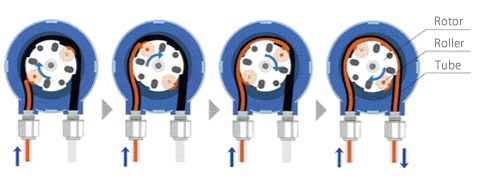How does a peristaltic pump work?
A peristaltic pump, also called a hose pump, peristaltic pump or roller pump, is a positive displacement pump. The hose is permanently installed in the pump housing. The rotating rotor squeezes the tubing and pushes the liquid through the tubing due to the rotary motion.
A peristaltic pump consists of a rotor with rollers (in the pump head), the pump housing and the hose. A product change is carried out very quickly, as only the hose is in contact with the liquid. No more tedious cleaning, remove the used hose and reinsert the new one, and the pump is ready for use again
- The principle of the peristaltic pump is based on an interplay of pressure and relief of the hose, whereby the product is pulled into the hose.
- The roller that rotates runs along the hose and compresses it. This creates a seal between the suction and pressure sides of the squeeze hose pumps, preventing backflow.
- As soon as the hose is relieved and returns to its original state, a strong vacuum is formed, whereby the product is sucked into the pump.
A distinction is made between peristaltic pumps with a maximum working pressure of approx. 2 bar and 16 bar. Up to 2 bar, they are mainly so-called dry-running pumps, where there is no lubricant in the pump head.
Advantages of peristaltic pumps
Hose pumps are the perfect solution when aseptic, corrosive or abrasive liquids are to be pumped or dosed. Since the product is only in contact with the hose, cleaning is easier. Shear-sensitive products, such as cell cultures, are gently conveyed. It also has no valves, seals or bushings, which simplifies maintenance. The hose is the only wearing part on a peristaltic pump, which simplifies spare parts inventory.
- Self-priming
- Dry-running capability
- Sealless design
- Low maintenance costs
- Gentle delivery
- High filling accuracy for dosing pump
- Reversible direction of rotation
- No product loss
